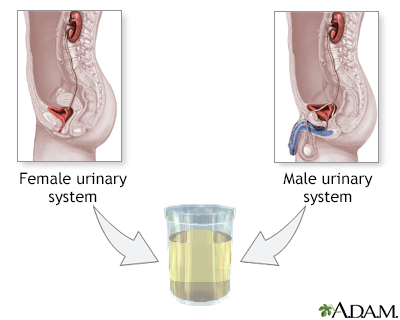5-HIAA urine test
HIAA; 5-hydroxyindole acetic acid; Serotonin metabolite
5-HIAA is a urine test that measures the amount of 5-hydroxyindoleacetic acid (5-HIAA). 5-HIAA is a breakdown product of a hormone called serotonin.
This test tells how much 5-HIAA the body is producing, which reflects how much serotonin is in the body.
Images

I Would Like to Learn About:
How the Test is Performed
A 24-hour urine sample is needed. You'll need to collect your urine over 24 hours in a container provided by the lab. Your health care provider will tell you how to do this. Follow instructions exactly.
How to Prepare for the Test
Your provider will instruct you, if necessary, to stop taking medicines that may interfere with the test.
Medicines that can increase 5-HIAA measurements include acetaminophen (Tylenol), acetanilide, phenacetin, glyceryl guaiacolate (found in many cough syrups), methocarbamol, and reserpine.
Medicines that can decrease 5-HIAA measurements include heparin, isoniazid, levodopa, monoamine oxidase inhibitors, methenamine, methyldopa, phenothiazines, and tricyclic antidepressants.
You will be told not to eat certain foods for 3 days before the test. Foods that can interfere with 5-HIAA measurements include plums, pineapples, bananas, eggplant, tomatoes, avocados, and walnuts.
How the Test will Feel
The test involves only normal urination, and there is no discomfort.
Why the Test is Performed
This test measures the level of 5-HIAA in the urine. It is often done to detect certain tumors in the digestive tract (carcinoid tumors) and to track the progress of a person with a carcinoid tumor.
Normal Results
The normal range is 2 to 9 mg/24h (10.4 to 46.8 µmol/24h).
Normal value ranges may vary slightly among different lab. Some labs use different measurements or test different samples. Talk to your provider about the meaning of your specific test results.
What Abnormal Results Mean
Abnormal results may be due to:
- Tumors of the endocrine system or carcinoid tumors
Risks
There are no risks with this test.
Related Information
Serotonin blood testTryptophan
Platelet count
References
Riley RS, McPherson RA. Basic examination of urine. In: McPherson RA, Pincus MR, eds. Henry's Clinical Diagnosis and Management by Laboratory Methods. 24th ed. Philadelphia, PA: Elsevier; 2022:chap 29.
Wolin EM, Jensen RT. Neuroendocrine neoplasms. In: Goldman L, Cooney KA, eds. Goldman-Cecil Medicine. 27th ed. Philadelphia, PA: Elsevier; 2024:chap 213.
BACK TO TOPReview Date: 8/21/2024
Reviewed By: Warren Brenner, MD, Oncologist, Lynn Cancer Institute, Boca Raton, FL. Review provided by VeriMed Healthcare Network. Also reviewed by David C. Dugdale, MD, Medical Director, Brenda Conaway, Editorial Director, and the A.D.A.M. Editorial team.

Health Content Provider
06/01/2025
|
A.D.A.M., Inc. is accredited by URAC, for Health Content Provider (www.urac.org). URAC's accreditation program is an independent audit to verify that A.D.A.M. follows rigorous standards of quality and accountability. A.D.A.M. is among the first to achieve this important distinction for online health information and services. Learn more about A.D.A.M.'s editorial policy, editorial process and privacy policy. A.D.A.M. is also a founding member of Hi-Ethics. This site complied with the HONcode standard for trustworthy health information from 1995 to 2022, after which HON (Health On the Net, a not-for-profit organization that promoted transparent and reliable health information online) was discontinued. |
The information provided herein should not be used during any medical emergency or for the diagnosis or treatment of any medical condition. A licensed medical professional should be consulted for diagnosis and treatment of any and all medical conditions. Links to other sites are provided for information only -- they do not constitute endorsements of those other sites. © 1997- 2025 A.D.A.M., a business unit of Ebix, Inc. Any duplication or distribution of the information contained herein is strictly prohibited.
